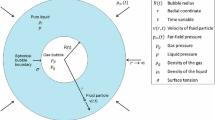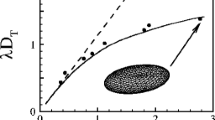Abstract
The response of an elastic Bingham fluid to oscillatory strain has been modeled and compared with experiments on an oil-in-water emulsion. The newly developed model includes elastic solid deformation below the yield stress (or strain), and Newtonian flow above the yield stress. In sinusoidal oscillatory deformations at low strain amplitudes the stress response is sinusoidal and in phase with the strain. At large strain amplitudes, above the yield stress, the stress response is non-linear and is out of phase with strain because of the storage and release of elastic recoverable strain. In oscillatory deformation between parallel disks the non-uniform strain in the radial direction causes the location of the yield surface to move in-and-out during each oscillation. The radial location of the yield surface is calculated and the resulting torque on the stationary disk is determined. Torque waveforms are calculated for various strains and frequencies and compared to experiments on a model oil-in-water emulsion. Model parameters are evaluated independently: the elastic modulus of the emulsion is determined from data at low strains, the yield strain is determined from the phase shift between torque and strain, and the Bingham viscosity is determined from the frequency dependence of the torque at high strains. Using these parameters the torque waveforms are predicted quantitatively for all strains and frequencies. In accord with the model predictions the phase shift is found to depend on strain but to be independent of frequency.
Similar content being viewed by others
Abbreviations
- A :
-
plate strain amplitude (parallel plates)
- A R :
-
plate strain amplitude at disk edge (parallel disks)
- G :
-
elastic modulus
- m :
-
torque (parallel disks)
- M :
-
normalized torque (parallel disks) = 2m/πR 3τ0
- N :
-
ratio of viscous to elastic stresses (parallel plates) =µ ω A/τ 0 ratio of viscous to elastic stresses (parallel disks) =µ ω A R/τ0
- r :
-
normalized radial position (parallel disks) =r/R
- r :
-
radial position (parallel disks)
- R :
-
disk radius (parallel disks)
- t :
-
normalized time =ω t — π/2
- t :
-
time
- γ E :
-
elastic strain
- γ P :
-
plate strain (displacement of top plate or disk divided by distance between plates or disks)
- γ PR :
-
plate strain at disk edge (parallel disks)
- γ 0 :
-
yield strain
- Γ E :
-
normalized elastic strain =γ E/γ0
- Γ P :
-
normalized plate strain =γ P/γ0
- Γ PR :
-
normalized plate strain at disk edge (parallel disks) =γ PR/γ0
- Γ 0 :
-
normalized plate strain amplitude (parallel plates) =A/γ 0 — normalized plate strain amplitude at disk edge (parallel disks) =A R/γ0
- δ :
-
phase shift betweenΓ P andT (parallel plates) — phase shift betweenΓ PR andM (parallel disks)
- µ :
-
Bingham viscosity
- τ :
-
stress
- τ 0 :
-
yield stress
- T :
-
normalized stress =τ/τ 0
- ω :
-
frequency
Reference
Yoshimura AS, Prud'homme RK, Princen HM, Kiss AD (1986) A Comparison of Techniques for Measuring Yield Stresses (to appear in J Rheol, 1987)
Author information
Authors and Affiliations
Rights and permissions
About this article
Cite this article
Yoshimura, A.S., Prud'homme, R.K. Response of an elastic Bingham fluid to oscillatory shear. Rheol Acta 26, 428–436 (1987). https://doi.org/10.1007/BF01333843
Received:
Issue Date:
DOI: https://doi.org/10.1007/BF01333843




